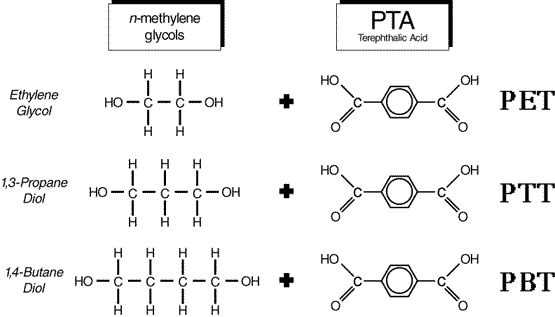|
|
|||||||||
|
|
|||||||||
| Introduction
CORTERRA* is the trade name for
polytrimethylene terephthalate (PTT), a thermoplastic that can be spun
into both fibers and yarns and has extensive applications in carpeting,
textiles and apparel, engineering thermoplastics, non-wovens, films and
monofilaments.
Polymer description The unique properties of PTT have been known for many years but the polymer has not been commercially available because of the high cost of production of the PDO raw material. Extensive research effort by Shell Chemicals has resulted in a cost-effective process to manufacture PDO. With this breakthrough in processing technology for PDO, CORTERRA Polymers are now commercially available for use in carpet fiber, textile fiber, monofilament, film, non-woven fabric, and engineering thermoplastic applications.
|
|||||||||||||||||||||||||||||||||||||||||||||||||||||||||||||
Properties
|
|||||||||||||||||||||||||||||||||||||||||||||||||||||||||||||
| Applications
Yarns made with CORTERRA Polymers can bring together the most appealing advantages, all in a single fiber. Fabrics made from CORTERRA Fibers not only offer easy-care and stretch, but a combination of features that include inherent stain resistance, lasting durability for longer wear, remarkable softness, beautiful fluid drape and rich brilliant colors. There also are benefits for textile manufacturers: CORTERRA Fibers dye well at low temperatures, blend well with other fibers, and are less expensive and much easier to work with than spandex
Fabrics made with CORTERRA Fibers have great appeal in the fast-growing stretch market. Unlike other stretch fabrics, these easy-care fabrics offer a combination of features that include the softness of nylon, beautiful drape and brilliant colors.
|
|||||||||||||||||||||||||||||||||||||||||||||||||||||||||||||
Grades
|
 |
||||||||||||||||||||||||||||||||||||||||||||||||||||||||||||
| Processability
|
|||||||||||||||||||||||||||||||||||||||||||||||||||||||||||||
| FAQ
What is CORTERRA? CORTERRA* is the
trade name for polytrimethylene terephthalate (PTT), a thermoplastic that
can be spun into both fibers and yarns. PTT belongs to a class of polymers
called aromatic polyesters. However, CORTERRA Polymer is a unique product
in that it behaves very differently than other polyesters. How, when, and by whom were CORTERRA Polymers or PTT discovered? PTT was first
patented in 1941 by Britons John Rex Whinfield and James Tennant Dickson,
two scientists with Calico Printing Ink, who were conducting a basic
research program on polyesters. How does CORTERRA compare with other fibers? CORTERRA combines the best properties of nylon and polyester. Whether used in carpet, garments, home furnishings or automotive fabrics, CORTERRA Fibers look better longer. Compared with other synthetic fibers like nylon and acrylic, CORTERRA Fibers feel softer, dye easier, retain vibrant colors longer, stretch and recover better. More important, CORTERRA Fibers resist staining, clean easily and dry quickly
Why is CORTERRA "the fiber of the future"? It is the first significant new material in the textile and carpet industry for some time. It provides manufacturers with a wider range of options for new products than they have now. As a stain- and static-resistant material, for example, CORTERRA PTT has those properties built in. These properties are not the result of additives. In carpeting, CORTERRA Fibers feel like wool and perform equal to or better than nylon 6,6. But they hold dyes much better, and that means manufacturers will have a wider color spectrum to chose from and produce carpets with a lasting, visual beauty. In apparel, CORTERRA Fibers offer performance that is equal to or better than nylon 6,6 and PET, including comfort fit due to superior stretch and recovery, excellent drape and softness and easy care due to stain resistance and a choice of care procedures. The target of PTT (and PBT) is not to take market share for PA or PP but to change the consumers perception of polyester in general, to regain market share partially lost by polyesters previously poor image. Once textured:
Comparison
Technical Info Ø PTT filament yarns at similar dtex per filament are softer than PET – they are as soft as PA Ø
Softness
comparison (+2 best/ -2 worst): Ø A PTT 3 dtex per filament is as soft as a PET with 2 dpf Ø Fine filaments are less resilient, a compromise between stretch and softness is necessary.
|
|||||||||||||||||||||||||||||||||||||||||||||||||||||||||||||
![]()
| Be notified of page updates |
wwwswicofilcom2015